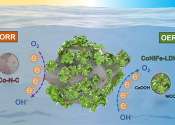Beat traffic by air: Israel flies drone taxi over Jerusalem
An air taxi flew over Jerusalem on Wednesday as part of an Israeli experiment to develop a network of drones to offer transport services and ease traffic congestion.
Sep 13, 2023
0
19
Automotive

An air taxi flew over Jerusalem on Wednesday as part of an Israeli experiment to develop a network of drones to offer transport services and ease traffic congestion.
Sep 13, 2023
0
19
Energy & Green Tech

A new U.S. Department of Energy (DOE) report finds promise in pairing nuclear reactors with carbon dioxide removal technologies, including direct air capture.
Sep 13, 2023
0
9
Energy & Green Tech

Heat pumps can be used to both cool and heat homes. The 2022 federal Inflation Reduction Act provides financial incentives for installing one. SciLine interviewed Theresa Pistochini of the Energy Efficiency Institute and ...
Sep 7, 2023
0
2
Engineering

A chilly winter morning, the car windshield shrouded in a thick layer of frost. Who has not experienced the frustration of scraping ice or waiting for the defroster to work? It is a daily winter struggle, but what if this ...
Sep 6, 2023
0
5
Business

The head of British air traffic control on Wednesday blamed a "one in 15 million" event that caused the country's worst systems failure in almost 10 years, stranding thousands of passengers.
Sep 6, 2023
0
14
Business

Delta Air Lines said Thursday that it has completed upgrading its fleet to protect key equipment against interference from 5G wireless signals, plugging a hole that could have disrupted flights during low visibility.
Sep 1, 2023
0
8
Energy & Green Tech

The wind doesn't always blow where it's needed–that's the biggest hurdle in fitting wind energy to the nation's portfolio of renewable energy. When the wind isn't blowing, utility companies must turn to other electricity ...
Aug 21, 2023
0
16
Energy & Green Tech

On June 12 this year, the UK's last remaining coal-fired power station was awoken from a 46-day slumber to meet demand for electricity to run air-conditioning units.
Aug 18, 2023
0
8
Energy & Green Tech

Zinc-air batteries have emerged as a better alternative to lithium in a recent Edith Cowan University (ECU) study into the advancement of sustainable battery systems.
Aug 18, 2023
1
83
Engineering

The U.S. Air Force will invest $235 million to help a start-up manufacturer build a jet with a blended-wing body that officials say could provide greater range and efficiency for military tankers and cargo planes and perhaps ...
Aug 17, 2023
0
3
The Earth's atmosphere is a layer of gases surrounding the planet Earth that is retained by the Earth's gravity. It has a mass of about five quadrillion metric tons. Dry air contains roughly (by volume) 78.08% nitrogen, 20.95% oxygen, 0.93% argon, 0.038% carbon dioxide, and trace amounts of other gases. Air also contains a variable amount of water vapor, on average around 1%. The atmosphere protects life on Earth by absorbing ultraviolet solar radiation, warming the surface through heat retention (greenhouse effect), and reducing temperature extremes between day and night.
There is no definite boundary between the atmosphere and outer space. It slowly becomes thinner and fades into space. An altitude of 120 km (75 mi) marks the boundary where atmospheric effects become noticeable during atmospheric reentry. The Kármán line, at 100 km (62 mi), is also frequently regarded as the boundary between atmosphere and outer space. Three quarters of the atmosphere's mass is within 11 km (6.8 mi; 36,000 ft) of the surface.
This text uses material from Wikipedia, licensed under CC BY-SA